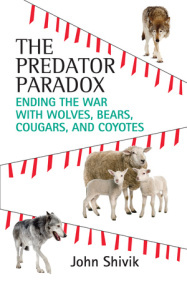
Transcript
This podcast is produced and presented by Craig Barfoot
In the 20th Century, humans killed hundreds
of thousands of wild animals as we sought to build new homes and
develop agriculture. Now the 21st century is characterised
by conservation and re-wilding - but can ranchers and environmentalists,
wildlife managers and animal-welfare activists, humans and animals ever
really co-exist?
Yes, says John Shivik of Utah State University’s National Wildlife Research Center /Predator Research in this fascinating conversation with Craig Barfoot.
And as carnivore populations increase their proximity to people, pets, and livestock leads to more conflict, and we are once again left to negotiate the uneasy terrain between elimination and conservation. In his book The Predator Paradox, John Shivik argues that we can end the conflict while still preserving and protecting these key species as fundamental components of healthy ecosystems.
As the boundary between human and animal habitat blurs, preventing the war between humans and wildlife depends both on changing animal behaviour and shifting our own perceptions, attitudes, and actions.
source

No comments:
Post a Comment